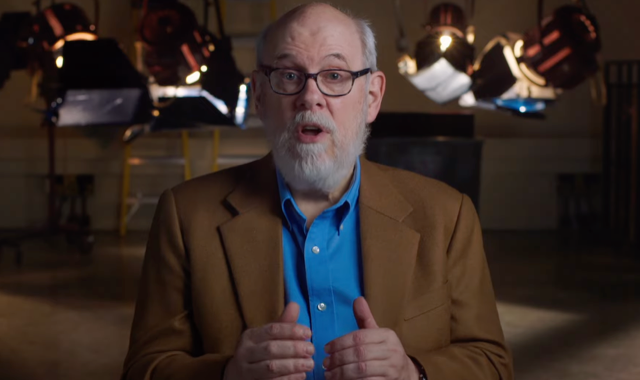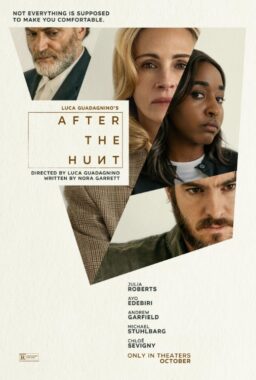David Bordwell was a teacher who became a friend. He opened my eyes to what cinema actually is. His influence on multiple generations of filmmakers, scholars, critics, and movie buffs is incalculable.
David wrote books on aspects of film style and genre, and how they intersected. He wrote about form as well as content, and the impact of one on the other—an increasing rarity in an anemic media landscape where film and TV criticism are increasingly uninterested in how things are said; which is to say, the art part of storytelling. Never in a million years would David publish a “take” on something, much less a “hot take.” He made arguments. More often, he explained things, or asked questions.
David reached people first through the books he published solo and in collaboration with his wife and fellow University of Wisconsin-Madison professor Kristin Thompson; after the turn of the millennium, he adapted to new technology, re-inventing his work for the CD-Rom format and starting a blog, davidbordwell.net, where he and Kristin published one-off essays. I don’t think David began to grasp the totality of his impact until the last few years of his life, when multiple generations of cinema appreciators quoted him, reached out to him, and got to know him. I was one of them.
I’ve loved movies all my life, but didn’t begin to understand their language until I was assigned Film Art: An Introduction in a basic film studies class in college, circa 1987, an illustrated scholarly text that explained how movies work in easily graspable language. Nothing was the same for me after that. Cowritten with Kristin and first published in 1979, Film Art is probably the most important book in the entire film studies canon, and has been in print continuously since the 1970s and translated into many languages. It’s about the language of pictures in cinema, i.e. how a filmmaker can say something about the story, characters, themes (or all three) through camera placement and editing.
The section of the book that has lived in my mind ever since is the one where Bordwell and Thompson analyzed the scene in Jaws (released just four years before Film Art!) where Hooper and Chief Brody confront the mayor of Amity over the shark problem. It hadn’t occurred to me before that part of the reason this scene and others are so effective is because Steven Spielberg blocks the actors in a way that reveals the shifting power dynamics between the characters.
Notice how Brody and Hooper are either standing together or separated by the mayor depending on whether the mayor is on defense or offense. Notice also how characters are diminished in size by the placement of the camera at key points. as when Brody rushes offscreen or into the background in frustration, or at the very end as they all stand beneath the vandalized billboard. This kind of stuff isn’t just garnish on the entree of story; it’s the means by which the entire meal is prepared. It affects you subconsciously even if you don’t know the slightest thing about filmmaking—much less neoformalism, the water Bordwell and Thompson usually swam in: a method of study that focuses on the formal characteristics of cinema in order to demonstrate what makes it different from other art forms.
We take for granted how important that kind of textbook was, and how hard it was to create in the pre-digital era. There were no desktop computers in 1979, and no home video to speak of. You couldn’t make screenshots. Maybe you could point a camera at a low-resolution TV showing a Betamax cassette of a movie, but that wouldn’t yield a good enough quality image for a college textbook. David told me that up until the 1990s, when laserdiscs and DVDs and home computers came into common use, he had to get ahold of actual 35mm prints of movies he wanted to include in his work, screen them in an actual theater or screening or editing room, and take actual photos on actual film with an actual camera on an actual tripod and develop them with actual chemicals in an actual darkroom.
I used “actual” excessively on purpose here, to drive home that each of these steps involved its own process and constituted a task (or tasks) that required training and skills, whether it was threading up a 35mm projector and fixing any problems that arose or calibrating a still camera to yield quality images of a movie flickering away in front of you. (It was possible to stop a film and go backwards, but not advisable because it could chew up the celluloid in the projector’s gears.) David was about as polite and cheerful a person as I’ve ever met in my life, but he was ferocious, and seemingly tireless, when it came time to commit and see a task through to the end.
The image of a young David standing for two hours in the back of a dark theater taking photos of a movie screen, day after day for weeks on end, is one that I think of often. It’s inspiring. He often went to those lengths, because it was the only way to gather the data he needed to complete whatever study he was engaged in.
Another example of his commitment: during the last couple of decades of his career, David wrote often about what he called “intensified continuity,” which is different from regular old movie continuity, the system by which commercial cinema lays out story and defines characters through an orderly pattern of long shots, medium shots and closeups. In older movies, which practiced what David and Kristin describe as “classical continuity,” directors relied more on blocking actors for the camera and then letting shots run long, compared to today, where the camera gets much closer much faster, the cuts are quicker, and there’s generally a lot more camera movement, much of it falling under the heading of what earlier generations of film scholars would call “unmotivated” (for instance, the way some action filmmakers have a camera circle groups of people very quickly to generate “excitement” even if they’re just having a regular old expository conversation).
To that end, one of David’s pet projects was watching films from different eras with a stopwatch and timing every shot to determine average shot length. This let him demonstrate in various articles and books not just that the average shot length in films had decreased over time, but by how much, which opened the gateway for speculation on why this was happening, and when it seemed to be organically integrated into the story (he thought Christopher Nolan and David Fincher did a good job with fast cutting) and when it seemed like pointless business or an attempt to cover up the fact that the director didn’t actually have a style. Kristin, meanwhile, was engaged in a similar sort of taxonomic study of cinema, and convincingly showed that, contrary to what most screenwriting books tell you, the shape of a story in most commercial films is not three acts, but four parts.
In recent years, David and Kristin started releasing most of their books online as free PDFs in order to further democratize the kind of film scholarship they’d devoted their lives to. A complete list of publications can be found on their website. One I want to single out here is Ozu and the Poetics of Cinema, a full study of the works of japanese master filmmaker Yasujiro Ozu (“Tokyo Story,” “Floating Weeds,” “Late Spring” et al) that focuses on how the master’s style articulates what he’s trying to say about people, families and societies in changing times; among other things, it shows that Ozu’s style, which is often described in the west as rigorous, austere or minimalist, was actually quite progressive for its time, aesthetically and politically. Another great one is Planet Hong Kong. David was among the first major American film scholars to take Hong Kong action cinema seriously as a form of artistic expression, not just popular spectacle. Readers may also be interested in Figures Traced in Light, which was generated from a series of articles about cinematic staging (i.e. blocking for the camera), focusing on four directors: “Louis Feuillade, master of the French silent serial; Kenji Mizoguchi, the great Japanese director; Theo Angelopoulos, the Greek filmmaker who rose to prominence in the 1970s; and Hou Hsiao‑Hsien, the distinguished Taiwanese director.”
In the blog post announcing the latter, there’s a phrase that jumps out at me, given all that David’s work has meant to so many: “theoretically guided film criticism.”
There’s never been much of a commercial space for film writing that even acknowledges the role of form, much less that gives it more or less equal emphasis with “content” (a word I despise now because of how the tech industry has corrupted it). A lot of people don’t even consider something to be criticism if it gets at content through form, or even if it gives a lot of space to the discussion of form. It’s almost impossible to do that type of writing anymore for a wide audience, except under very particular circumstances (such as this platform, Vulture, The New Yorker, and a few other major outlets) and it tends to be minimized in regular reviewing. That’s what prompted me to write what ended up being one of my most-read and most controversial pieces (though I never intended it as such), “Please, Critics, Write About the Filmmaking,” which David predictably loved, since I wrote it partly as a way of continuing the work he and Kristin had always done.
“Preconceived methods, applied simply for demonstrative purposes, often end by reducing the complexity of films,” David and Kristin once wrote. That’s a sentiment I heartily agree with. It bears repeating today, now that so much of “cultural writing” consists of “takes” that discuss works of moving image art as if they were pamphlets or PDFs, and that seem mainly interested in provoking a response, often with all the grace and erudition of a stick in the eye.
I never had David for a class, but based on my conversations with him, he must have been a marvelous teacher. He once explained classical continuity versus intensified continuity to me by citing Howard Hawks’ classic screwball comedy “Bringing Up Baby” as an example of the older type of continuity. Filmmakers in the pre-television era, he said, tended not to cut unless they felt there was a reason. They also understood that performances in a physical comedy are funnier if the camera stays farther back and shows us most or all of the performers’ bodies, so that they are somewhat diminished in the frame and we begin to think of them almost as machines or objects or dolls. The more we see them as warm, complicated, psychologically plausible human beings (mainly through closeups) the less likely we are to belly-laugh. That’s why Hawks doesn’t give us the first closeup in “Bringing up Baby” until halfway through the movie, when he cuts to a shot of Katharine Hepburn as she silently realizes she’s in love with Cary Grant. The moment leaps out and is unexpectedly powerful because the director hasn’t been jamming the camera up into actors’ nostrils for the preceding 45 minutes. “Your brain thinks, ‘Oh, this is different, this might be important’ and then you wonder why,” David told me. “In a lot of modern movies, the closeup is the default.”
David was wildly productive right up to the end, writing books under his own byline and in collaboration with Kristin, and contributing essays to other people’s work. (David did essays for three of the books in my Wes Anderson Collection Series: The Grand Budapest Hotel, The French Dispatch, and a forthcoming, not-yet-scheduled book on Asteroid City. The French Dispatch book is dedicated to him and Kristin, and he wrote the introduction to Asteroid City.) He remained plugged into the world of film criticism and scholarship, often making a point to seek out and mentor younger writers who had been inspired by his and Kristin’s work. And he was generous in acknowledging the contributions of others: a blog post from last year on James Cutting’s book Movies on Our Minds: The Evolution of Cinematic Engagement (which, like so much film scholarship, would not have existed without Bordwell and Thompson’s work) is not only extravagant in its praise for Cutting but goes out of its way to mention six other film scholars in the space of a single paragraph. David was always keen to let people know when he’d cited their work or said something nice about him, and there are probably thousands of people out there who, over the decades, had their days made by the arrival of a Bordwell email with the subject header, “You’ve been BLOGGED!”
David once wrote to me years ago that he didn’t see the sorts of video essays I’d started doing in the mid-aughts as being all that similar to the picture-augmented formal analysis that he and Kristin did in their books. But he later came around to the idea that they were different paths toward the same destination. I think he proved it beyond all doubt in the pieces that he did for Criterion Channel with Kristin and Jeff Smith, which are compiled here. It’s one more astonishing body of work to accompany all the others.
The world already seems like a poorer place without him. The best way to honor his memory is to talk about filmmaking. The stuff the dreams are made of.












